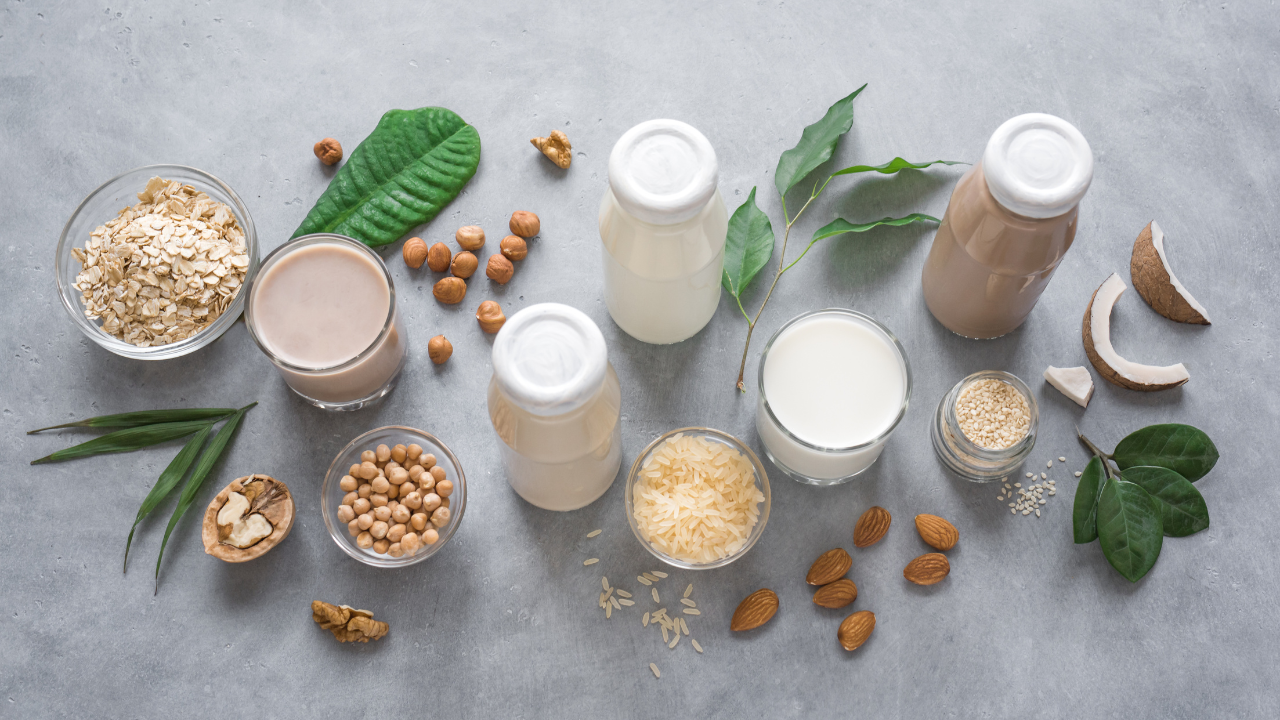How to Choose the Right Milk for You
DISCLAIMER: Links included in this blog might be affiliate links. Health with Hannah, LLC is a participant in the Amazon Services LLC Associates Program along with other affiliate programs. If you purchase a product or service with the links that I provide I may receive a small commission with no additional charge to you. Thank you for your support!
Ah, the great milk debate of the 21st century. These days, there are so many varieties of milk on the shelves at the grocery store. Many coffee shops now offer a handful of milk alternatives for your cup of joe.
For people with dairy allergies and intolerances, having so many options is surely a positive. However, all of these choices can also feel overwhelming. How do you determine which type of milk you should choose?
Table of contents:
Considerations for choosing the best milk for you
There are a few factors that you may consider when determining which type of milk you choose to purchase.
Allergies and intolerances
Individuals with dairy allergies are advised to avoid cow’s milk and products made with cow’s milk, such as cheese, yogurt, and ice cream.
A dairy allergy is not the same thing as an intolerance. Food intolerances and food allergies are caused by different biological processes and they are diagnosed and treated differently.
In those with a dairy allergy, their immune system identifies milk protein as harmful, which triggers the production of antibodies and causes allergic symptoms.
Some people have lactose intolerance, which is a digestive condition that makes it difficult to digest lactose, a type of carbohydrate (sugar) naturally found in dairy products. Lactose intolerance is usually caused by low levels of lactase, an enzyme produced in the small intestine that breaks down lactose.
Those with lactose intolerance may be able to comfortably tolerate some dairy products. Lactose intolerance is a spectrum and different dairy products contain varying amounts of lactose. For example, someone with lactose intolerance may be able to enjoy a small amount of hard cheese but not a glass of cow’s milk.
There are a variety of lactose-free milks available on the market, as we will discuss below. Some brands even off lactose-free yogurt and ice cream, as well.
Some people have allergies or intolerances to other ingredients in milk alternatives. For example, someone with a tree nut allergy should avoid almond milk and other milk alternatives that contain tree nuts.
Taste preferences
You should enjoy the foods and beverages that you consume! While there are many reasons why we make a food choice, taste should always be considered. For example, if you dislike almond milk, don’t drink it just because someone online says it is the “best” choice.
Each of the milk alternatives have a slightly different flavor. Try different types and see what you like. You may even find that you enjoy different milks for different applications. I love using coconut milk to make chia pudding, but I personally dislike it in my coffee.
Cow’s milk drinkers tend to have a preference of which type they enjoy based on the taste and mouthfeel. It’s okay to keep these considerations in mind along with factors such as price and nutrition.
Nutrition profile
Each milk and milk alternative has a different nutrition profile, as highlighted below. If you are looking for a high protein option, cow’s milk and soy milk may be the way to go. If you rely on milk for calcium, be sure to read the nutrition facts label to see the calcium content.
As a non-diet dietitian, I need to remind you that not everything we eat or drink needs to be optimized for a particular nutrient. For example, it’s okay if you choose a low-protein milk option like coconut milk because chances are, you are consuming many other foods and beverages throughout the day that will provide your body with protein.
TLDR: nutrition is only one of many factors to consider when making a food choice.
Budget
You may have noticed that each type of milk comes at a different price point. Choose what makes sense for you and your family. And remember that just because a food or beverage is expensive, this does not automatically mean that it is “healthier”.
Types of cow’s milk
Cow’s milk is a nutrient-dense choice with 13 essential nutrients, including protein, calcium, and vitamin D. Learn all about dairy’s health benefits here.
There are several different types of cow’s milk to choose from. All cow’s milk contains the same essential nutrients and the main difference is the type of fat they contain.
Whole milk
Whole milk is cow’s milk that retains its natural fat content. This is the variety that is closest to how it comes from the cow. Whole milk contains about 3.5% fat. You might notice that whole milk has a thicker and creamier texture than lower fat milks.
2% reduced-fat milk
2% reduced-fat milk contains 2% fat. This means that milk fat (sometimes called butterfat) makes up 2% of the total weight of the milk.
1% low-fat milk
1% low-fat milk contains, you guessed it, 1% milk fat. Again, this means that fat makes up 1% of the total weight of the milk.
Low-fat and reduced-fat milk is not “watered down” whole milk. Dairy products are highly regulated and have a “standard of identity”. This means that milk with water added to it could no longer be called milk.
Skim or non-fat milk
Skim milk (also called skimmed milk and non-fat milk) is milk that has nearly all of the fat removed. It is sometimes called skim milk because the cream (which contains the fat) is quite literally “skimmed” off the top before being bottled and distributed to your grocery store. Skim milk contains no more than 0.2% milk fat.
Lactose-free milk
Advances in food science and technology has allowed for milk companies to make more of what consumer’s want and need. One of these advancements has included the production of lactose-free cow’s milk.
Lactose-free milk is made by either adding the lactase enzyme to the product (which helps your body to digest the lactose) or using a filtration process to remove the lactose.
Common brands of lactose-free milk include Fairlife and Lactaid. Many store brands now offer lactose-free varieties as well.
A2 milk
A2 milk is a relatively new type of “real milk” on the market with all of the same nutrients you’d find in typical cow’s milk. The difference between A2 milk and regular cow’s milk is in the protein structures.
Milk contains two primary types of protein: whey and casein. There are different subtypes of casein, including A1 and A2. Typical cow’s milk contains both A1 and A2 casein, but A2 milk comes from cows that only produce the A2 casein. Some people find that A2 casein is easier on the digestive system and they tolerate A2 milk better than traditional milk.
A2 milk is not suitable for those with a milk allergy and it does contain lactose and may not be recommended for those with lactose-intolerance.
Types of milk alternatives
If you have a dairy allergy, a lactose-intolerance, or you simply enjoy the taste of milk alternatives, there are many to choose from!
Milk alternatives are sometimes called plant-based milk beverages or mylks, as they technically do not meet the standard of identity to be classified as milk. For the sake of this article, however, I will refer to the plant-based options as types of milk.
The exact nutrition profile of each plant-based milk will depend on the brand and the variety. Read the nutrition facts label on the product to determine which option is best for you.
Soy milk
Soy milk contains the most similar nutrition profile to cow’s milk and comes in many varieties, including different flavors and extra creamy options.
Silk is a popular soy milk brand. Many grocery stores also offer a generic store brands as well.
Almond milk
Most almond milk is lower in protein than cow’s milk so it is a good rule of thumb to include other protein sources in your diet. Calcium and vitamin D are sometimes added to almond milk. Unsweetened almond milk is typically low in carbohydrates.
Almond Breeze and Califia Farms are popular almond milk brands.
Coconut milk
Coconut milk is also low in protein and should not be relied on as a protein source. Coconut milk has a distinct flavor and makes a great addition to certain recipes. You can usually find coconut milk in cartons and in cans.
Oat milk
Oat milk has become a trendy milk alternative option. Oat milk has a mild oat flavor and makes a great addition to coffee and cereal.
Most oat milk has a higher carbohydrate content than some of the other plant-based milks. Oat milk is typically not a high-protein option. Calcium and vitamin D are sometimes added to oat milk.
Rice milk
Rice milk typically contains carbohydrates and is low in protein and fat. Rice milk is low in potassium and phosphorus, making it a good choice for people with chronic kidney disease.
Rice milk tends to have a sweet taste and many varieties have natural or artificial flavoring added. Calcium and vitamin D are sometimes added as well.
Hemp milk
Hemp milk, or hemp seed milk, is made from hemp seeds that are soaked in water and ground. The fats in hemp milk are mostly unsaturated, including omega-3 fatty acids. Some varieties are also a good source of iron.
Cashew milk
Cashew milk has a mild, nutty flavor and comes in sweetened and sweetened varieties. Calcium and vitamin D are often added. Some cashew milks will also be a source of iron. Cashew milk is not a high-protein food.
Pea milk
Pea milk is made from pea protein, making it a higher protein option compared to its other plant-based milk counterparts. Pea milk may also be an option for those with soy or nut allergies.
Bottom line
Ultimately, the best milk for you will depend on your preferences and dietary needs. You may even find that you enjoy different milks for different applications. Always read the food label for allergy information.
What did you think of this post? Leave a comment below.
Disclaimer: this post is for informational and educational purposes only and is not a substitute for professional medical advice.




































